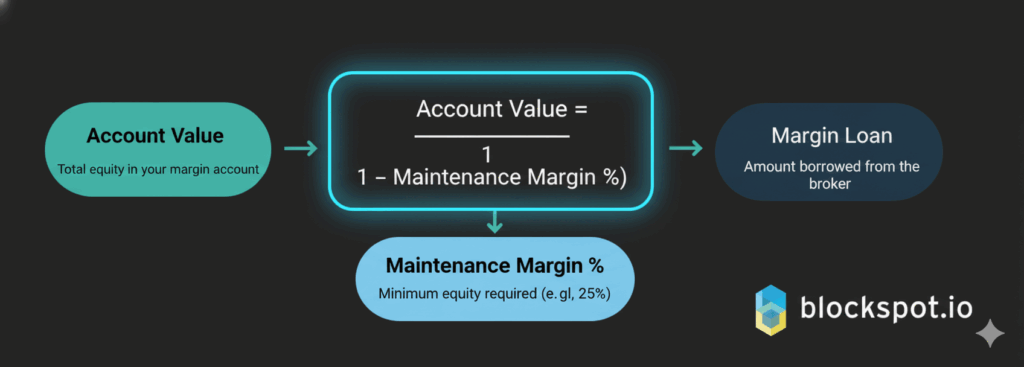Trading with borrowed funds can amplify both gains and losses. That’s why brokerage firms enforce maintenance margin rules to protect both traders and brokers from rapid market swings that could lead to insolvency. Understanding how this works is essential before using margin or leverage in your portfolio.
What Is a Maintenance Margin?
The maintenance margin is the minimum amount of equity an investor must maintain in a margin account after purchasing securities with borrowed funds. It acts as a safety buffer, ensuring the investor can cover potential losses if asset values decline.
According to the Financial Industry Regulatory Authority (FINRA), the minimum maintenance margin is 25%, but many brokers set their own limits between 30% and 40% for added protection. This buffer is especially important when trading volatile assets like cryptocurrencies, where prices can change within minutes.

Initial vs. Maintenance Margin
It’s important to distinguish between the initial margin and the maintenance margin:
- Initial Margin – The amount required to open a position.
- Maintenance Margin – The ongoing equity needed to keep that position open.
When you buy securities using margin, the broker lends part of the purchase price, while you provide the rest as equity. The Federal Reserve’s Regulation T currently limits this borrowing to 50% of the purchase price.
Once the trade is active, the maintenance margin must always be met. If the asset price drops and your equity falls below this threshold, the broker issues a margin call requiring you to deposit more funds or sell assets to restore the balance.
Example: Margin Call in Action
Let’s say you buy 100 shares at $60 each using 50% margin.
- You invest $3,000 of your own money and borrow $3,000 from the broker.
- If the stock drops to $40, your total position value falls to $4,000.
- Your equity becomes $1,000, or 25%, which may trigger a margin call depending on the broker’s requirements.
The formula to find when a margin call occurs is:

Example:
For a $10,000 loan with a 30% maintenance margin:
[
10,000 / (1 – 0.30) = 14,285.71
]
If your account value falls below $14,285.71, a margin call is triggered.
When and Why Brokers Change Margin Requirements
Brokers can raise maintenance margin levels at any time, especially during market volatility. This flexibility helps them manage risk when asset prices swing sharply.
For example:
- Highly volatile stocks or ETFs like TQQQ or UVXY may require a 60–100% maintenance margin.
- Crypto-linked stocks such as Coinbase (COIN) or MicroStrategy (MSTR) can see requirements above 50% during price surges.
- Penny stocks and unlisted assets are often non-marginable, meaning you must pay 100% upfront.
What Happens After a Margin Call
Once a margin call is issued, traders typically have 2–5 days to meet the requirement. You can do this by:
- Depositing more cash or securities
- Selling part of your holdings to reduce the loan balance
If you fail to act, the broker has the right to liquidate your positions without notice. Forced sales may incur extra commissions or interest fees, and if losses exceed your equity, you could owe money to the broker.
This is why margin trading carries high risk; investors can lose more than their initial investment.
How Maintenance Margin Protects Brokers
Maintenance margins exist primarily to protect brokers, not investors. They ensure brokers don’t face losses when market conditions deteriorate faster than traders can react.
In a leveraged system, initial margin opens the position, while maintenance margin keeps it alive. Together, they prevent cascading defaults in fast-moving markets.
Key Points to Remember
- Maintenance margin is the ongoing equity you must maintain in a margin account.
- A margin call happens when your equity drops below that threshold.
- Brokers can change margin rules anytime, especially during high volatility.
- Failure to meet a margin call can lead to forced liquidation of assets.
- Investors may lose more than their initial capital and owe the broker additional funds.
- Maintenance margin protects brokers, not traders, from financial losses.
Avoiding Margin Call Pitfalls
Margin trading offers the opportunity to amplify profits, but it also magnifies risk. Maintenance margin isn’t a limitation; it’s a safeguard that keeps the market functioning when volatility strikes.
Before using margin, always:
- Read your broker’s margin agreement carefully.
- Understand both initial and maintenance requirements.
- Keep backup capital ready in case of a margin call.
Used wisely, margin can be a powerful tool for growth. But used carelessly, it can turn small mistakes into major financial losses.


